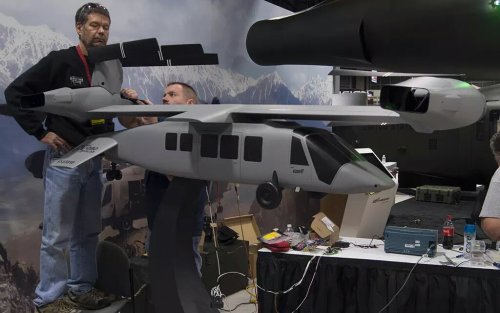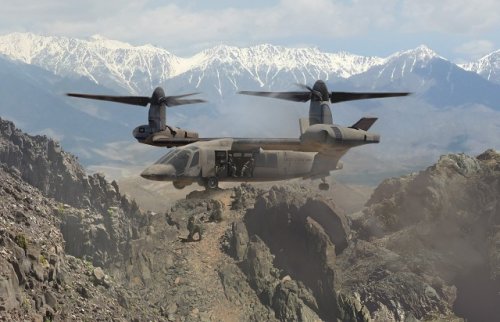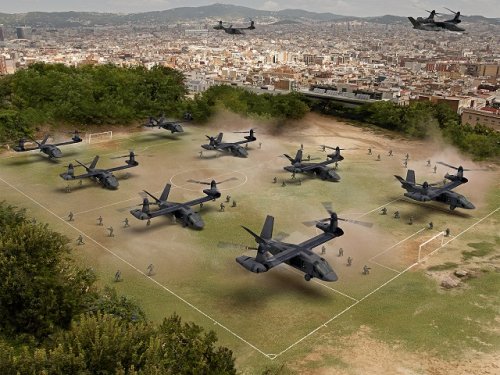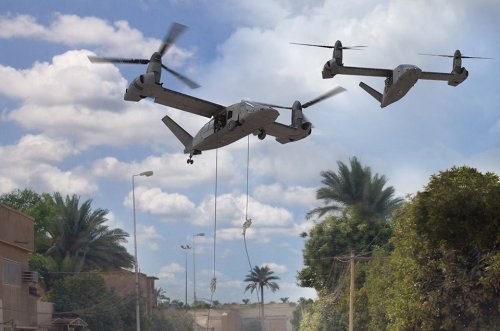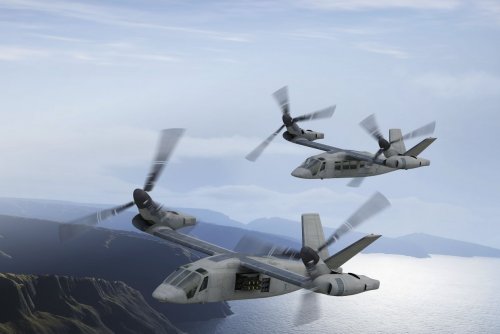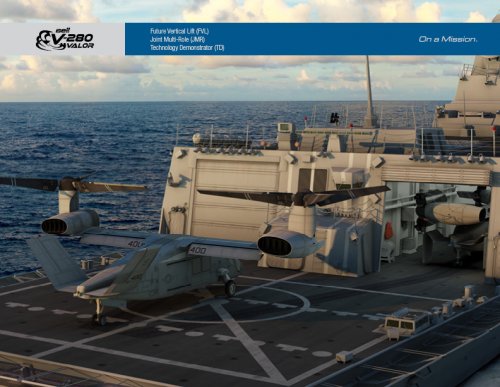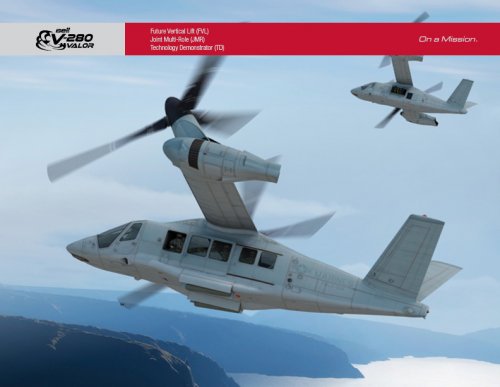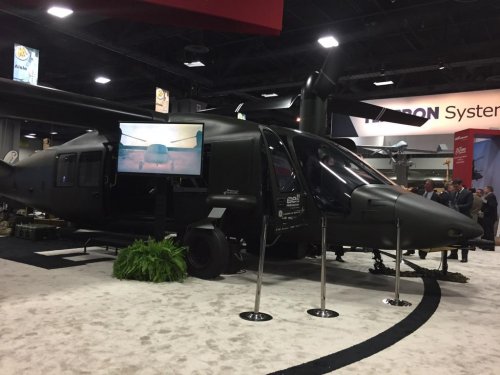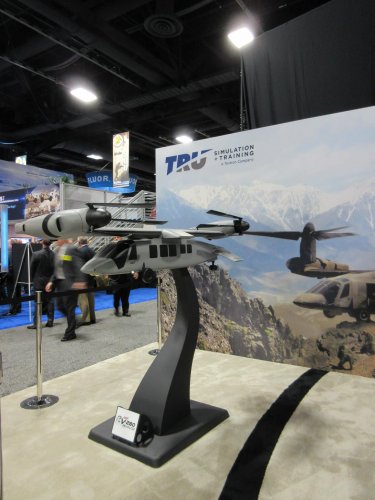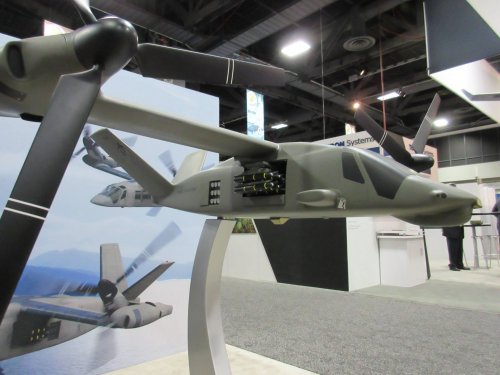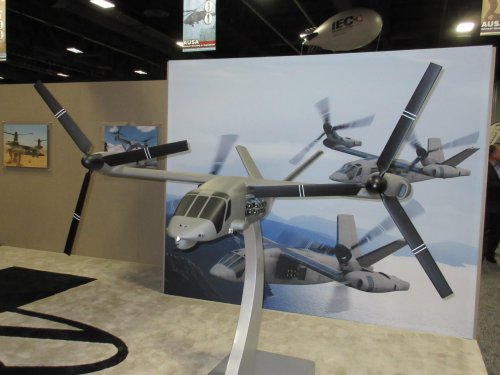You are using an out of date browser. It may not display this or other websites correctly.
You should upgrade or use an alternative browser.
You should upgrade or use an alternative browser.
Bell V-280 Valor
- Thread starter RavenOne
- Start date
"Spirit delivers first V-280 tiltrotor aircraft fuselage to Bell (+video) "
by Jerry Siebenmark
The Wichita Eagle
September 22, 2015
Source:
http://www.kansas.com/news/business/aviation/article36123228.html
Published on Sep 22, 2015
https://youtu.be/7Fkf6e9y8XM
by Jerry Siebenmark
The Wichita Eagle
September 22, 2015
Source:
http://www.kansas.com/news/business/aviation/article36123228.html
Published on Sep 22, 2015
Bell Helicopter CEO John Garrison talks about Spirit AeroSystems' first V-280 fuselage delivery and the advantages of a tilt rotor aircraft over a helicopter on the battlefield. Video by Jerry Siebenmark.
https://youtu.be/7Fkf6e9y8XM
Slideshow of fuselage:
http://www.bizjournals.com/wichita/news/2015/09/22/spirit-aerosystems-rolls-out-v-280-helicopter.html#g1
http://www.bizjournals.com/wichita/news/2015/09/22/spirit-aerosystems-rolls-out-v-280-helicopter.html#g1
- Joined
- 4 July 2010
- Messages
- 2,509
- Reaction score
- 3,075
Did they redesign the nacelles to be lifting bodies?Triton said:"Spirit delivers first V-280 tiltrotor aircraft fuselage to Bell (+video) "
by Jerry Siebenmark
The Wichita Eagle
September 22, 2015
Source:
http://www.kansas.com/news/business/aviation/article36123228.html
Published on Sep 22, 2015
Bell Helicopter CEO John Garrison talks about Spirit AeroSystems' first V-280 fuselage delivery and the advantages of a tilt rotor aircraft over a helicopter on the battlefield. Video by Jerry Siebenmark.
https://youtu.be/7Fkf6e9y8XM
September 21, 2015
"Bell Helicopter exploring civilian market for new tilt-rotor aircraft"
By Thomas Black
Bloomberg News
Source:
http://www.star-telegram.com/news/business/article35969325.html
"Bell Helicopter exploring civilian market for new tilt-rotor aircraft"
By Thomas Black
Bloomberg News
Source:
http://www.star-telegram.com/news/business/article35969325.html
Bell Helicopter is reviving its vision of finding a civilian market for tilt-rotor aircraft.
That dream first took shape almost two decades ago in a partnership with Boeing for a commercial aircraft based on the V-22 Osprey, the pioneering tilt-rotor built for the Marines that takes off like a helicopter and cruises like a plane. But Boeing bowed out early and Bell sold its interest in the civilian version in 2011 to AgustaWestland.
Now Bell is working on a new tilt-rotor to be demonstrated to the U.S. military as a possible replacement for the UH-60 Black Hawk helicopter. The V-280 Valor could be cheap enough to appeal to business customers as well, Chief Executive Officer John Garrison said.
“You’re getting into a quantity level where the cost per unit is going to get to a point where it could be very competitive in a commercial space,” Garrison said in an interview at Bell’s headquarters in Fort Worth.
Bell, a unit of Textron, has spoken with customers about the possibility of a civilian tilt-rotor aircraft as part of its normal conversations about market demand, Garrison said, without providing details. Bell will receive the first fuselage next week for the V-280, which it’s building with supplier partners including Lockheed Martin.
A tilt-rotor’s blades spin horizontally to lift off like a helicopter. Then they gradually rotate forward like oversize propellers, providing the speed and range of an airplane. The Marines wanted those capabilities to reach combat zones. When Bell talked up its civilian 609 offering in the 1990s, it envisioned executives making fast trips from helipads or oil workers zipping to distant offshore platforms.
AgustaWestland, a unit of Italy’s Finmeccanica, is doing test flights of its Bell-derived tilt-rotor, now known as the AW609, and expects to obtain flight certification by 2017. Bell has engineering and manufacturing service contracts with AgustaWestland for the project, Garrison said.
“We’re following their certification efforts on the 609 very closely,” he said. “We want them to be successful.”
Bell’s V-280 is part of a competition with Black Hawk maker Sikorsky for a new high-speed military rotorcraft. With Boeing as a partner, Sikorsky is building the S-97 Raider, a more traditional helicopter. Garrison said Bell’s agreements on the V-280 remain in place even with Lockheed’s $9 billion deal to buy Sikorsky from United Technologies.
Military needs drove the Osprey, which is big — it can carry 24 seated troops — and not cheap. Each one cost $89 million in 2005 dollars, according to a U.S. Air Force fact sheet. With the Pentagon’s focus on paring expenses for the V-280, private users are more likely to be attracted to a civilian version, Garrison said.
“When you hit that value proposition with the volumes that we’re talking about, there may be an opportunity for a commercial tilt-rotor of that size,” he said. “We’d like to believe there’s an opportunity.”
Business
Read more here: http://www.star-telegram.com/news/business/article35969325.html#storylink=cpy
But what is the lateral movement latency of tiltrotor vs helicopter? I can now see (thanks Yasotay) where this would be a real chore in tight quarters or winds, and more so for civilian usage where the landing spots are even tighter.
marauder2048
"I should really just relax"
- Joined
- 19 November 2013
- Messages
- 3,157
- Reaction score
- 926
sferrin said:Makes you wonder why they ever gave up their stake in the 609. ???
So that Bell could free up cash to develop the 525 and 505 while AW's deeper pocketed parent company drags
the 609 through certification hell.
- Joined
- 18 October 2006
- Messages
- 4,203
- Reaction score
- 4,880
+1marauder2048 said:sferrin said:Makes you wonder why they ever gave up their stake in the 609. ???
So that Bell could free up cash to develop the 525 and 505 while AW's deeper pocketed parent company drags
the 609 through certification hell.
Bell decided that they could not get a good market share given the expected cost required to bring a new aircraft type through the byzantine FAA process. Now that AW has gone through the pain for the community, others will start looking to get into the high speed VTOL market. Supposition on my part.
Couple of points regarding the lateral capabilities. A tilt rotor is like a CH-47 as far as directional control in winds I am told. Also, I suspect that the government has maneuver standards that must be adheared to in order to meet specification. Can't imagine Bell spending that sort of money if they cannot meet the governments requirement. That seems awefully high risk for a conservative corporation like Textron.
Re-reading Bell Helicopter Chief Executive Officer John Garrison's comments, I believe that a civilian V-280 Valor is dependent on winning the FVL-Medium competition.
- Joined
- 24 November 2008
- Messages
- 1,547
- Reaction score
- 2,600
More pictures: http://www.bizjournals.com/wichita/news/2015/09/22/spirit-aerosystems-rolls-out-v-280-helicopter.html#g6
Edit: Sorry, just saw it was already posted
Edit: Sorry, just saw it was already posted
SteveO said:Looks like the model might show a V-22 style wing fold.
The last thing it needs is more complexity.
sublight is back said:SteveO said:Looks like the model might show a V-22 style wing fold.
The last thing it needs is more complexity.
Perhaps the Bell V-280 Valor will fit in the hangers of United States Navy frigates, destroyers, and cruisers.
Triton said:sublight is back said:SteveO said:Looks like the model might show a V-22 style wing fold.
The last thing it needs is more complexity.
Perhaps the Bell V-280 Valor will fit in the hangers of United States Navy frigates, destroyers, and cruisers.
That complexity is going to eat into its range and speed advantages and increase its maintenance costs. The Valor program really needs to stick with having the largest advantages over Raider as it possibly can. The manoeuvrability latency issue is already going to be a sticking point.
- Joined
- 18 October 2006
- Messages
- 4,203
- Reaction score
- 4,880
I suspect that Valor team has both options covered so if the Army decides it does not want to have all of the folding equipment, it can do so. This is a likely impact of significance for both competitors. Putting a fold system on the Sikorsky-Boeing is going to add ~ 1000lbs to that big rotorhead. This also means more bits hanging on the rotorhead which means more drag, which needs more power to overcome, which means less speed and range. If you are going to sell either of these new rotorcraft to the USN/USMC it will have to have automatic fold so it can go underdeck. It will no doubt change the performance to either of the base aircraft.
As to the maneuver latency issue I do agree that will be something to watch. I do not think that it is necessarily a given that the Sikorsky design has that much advantage. I will defer to anyone with more aero-engineering than me (I just flew the darn things). But as I pointed out the Army and DoD has minimum acceptable maneuver criterion, that anyone who has to compete will be judged against. If you cannot meet them, you are at a disadvantage... unless your rotorcraft is cheaper.
As to the maneuver latency issue I do agree that will be something to watch. I do not think that it is necessarily a given that the Sikorsky design has that much advantage. I will defer to anyone with more aero-engineering than me (I just flew the darn things). But as I pointed out the Army and DoD has minimum acceptable maneuver criterion, that anyone who has to compete will be judged against. If you cannot meet them, you are at a disadvantage... unless your rotorcraft is cheaper.
- Joined
- 18 October 2006
- Messages
- 4,203
- Reaction score
- 4,880
From the above article - “They [Bell ] are also building additional flapping into the rotor system and individual controls that should allow for increased low-speed maneuverability.”bobbymike said:
So it seems that they are focused on improving the low speed maneuverability.
- Joined
- 3 October 2007
- Messages
- 1,960
- Reaction score
- 1,192
marauder2048 said:sferrin said:Makes you wonder why they ever gave up their stake in the 609. ???
So that Bell could free up cash to develop the 525 and 505 while AW's deeper pocketed parent company drags
the 609 through certification hell.
That and they hired a high ranking executive from Sikorsky who made no bones about the fcct that he was not a Tilt Rotor fan.
- Joined
- 3 October 2007
- Messages
- 1,960
- Reaction score
- 1,192
yasotay said:I suspect that Valor team has both options covered so if the Army decides it does not want to have all of the folding equipment, it can do so. This is a likely impact of significance for both competitors. Putting a fold system on the Sikorsky-Boeing is going to add ~ 1000lbs to that big rotorhead. This also means more bits hanging on the rotorhead which means more drag, which needs more power to overcome, which means less speed and range. If you are going to sell either of these new rotorcraft to the USN/USMC it will have to have automatic fold so it can go underdeck. It will no doubt change the performance to either of the base aircraft.
As to the maneuver latency issue I do agree that will be something to watch. I do not think that it is necessarily a given that the Sikorsky design has that much advantage. I will defer to anyone with more aero-engineering than me (I just flew the darn things). But as I pointed out the Army and DoD has minimum acceptable maneuver criterion, that anyone who has to compete will be judged against. If you cannot meet them, you are at a disadvantage... unless your rotorcraft is cheaper.
just popping in for a moment...
The concept of rotating the wing structure on a maritime version of the V-280 has been seen before. What is significantly different here is the smaller tail unit. In previous iterations, one of the tails folded down so that the engine/proprotor assembly would clear. The didn't happen in the larger V-22 because its wing was shorter proportional to its fuselage in order to meet the requirement to operate abeam the island on ship. It looks like the new tail is small enough that it won't have to fold.
F-14D said:That and they hired a high ranking executive from Sikorsky who made no bones about the fcct that he was not a Tilt Rotor fan.
Interesting.
- Joined
- 18 October 2006
- Messages
- 4,203
- Reaction score
- 4,880
You mean the one who is now an Emeritus at Sikorsky?Triton said:F-14D said:That and they hired a high ranking executive from Sikorsky who made no bones about the fcct that he was not a Tilt Rotor fan.
Interesting.
"Bell and Lockheed modify V-280 contract ahead of Sikorsky takeover"
12 October, 2015 BY: James Drew Washington DC
Source:
https://www.flightglobal.com/news/articles/bell-and-lockheed-modify-v-280-contract-ahead-of-sik-417664/
12 October, 2015 BY: James Drew Washington DC
Source:
https://www.flightglobal.com/news/articles/bell-and-lockheed-modify-v-280-contract-ahead-of-sik-417664/
Lockheed Martin’s pending acquisition of Sikorsky has caused some contractual changes between Lockheed and Bell Helicopter for V-280 Valor development to ensure there is no cross pollination with its competitor, the Boeing-Sikorsky SB-1 Defiant.
Bell president and chief executive John Garrison says Lockheed continues to be a good partner on the programme and already follows many of the firewalling policies now solidified in the contract.
Bell and Lockheed have been partnered on the V-280 since 2013, with first flight under the US Army’s Joint Multi-Role Technology Demonstration (JMR-TD) programme planned for September 2017. Lockheed is developing the third-generation tiltrotor aircraft’s mission system, and its $9 billion acquisition of Sikorsky will place it on the opposing SB-1 team with Boeing.
Textron chief executive Scott Donnelly and Lockheed head Marillyn Hewson are said to have discussed the issue when the acquisition was announced in July, and the two sides have appear to have resolved any competing interests.
"Lockheed called me and said, ‘this is the world we operate in. We can put in firewalls. We compete on some programmes and cooperate on others,’” Garrison said at the Association of the United States Army (AUSA) conference in Washington this week. “We actually had a contractual change, and they’ve committed to a lot of things they were in fact doing as part of the programme. Lockheed has been a great teammate and done everything we’ve asked, plus – and we believe they’ll continue to do that.”
JMR-TD aims to mature two competing rotorcraft design in preparation for the army’s upcoming Future Vertical Lift programme, which is currently aiming for initial operational capability in 2035.
Bell believes the V-280 could be delivered to military users seven to 10 years ahead of that schedule.
Spirit AeroSystems delivered the first composite fuselage to Bell’s Amarillo plant in September, and the GKN Aerospace V-tail aerostructure is due to arrive for mating in 2016.
Garrison says his preferred time line would place IOC in 2026 or 2027, and the engineering and manufacturing development phase should begin soon after the first flight.
“We don’t need to do another five- or 10-year technology development phase as we go forward,” he says. “There’s an absolute need for this capability and we can move faster than the current acquisition process is playing out.”
Boeing and Sikorsky have expressed a similar sentiment on their side.
Garrison says for every $1 being spent by the US government on the JMR-TD endeavour, industry is spending approximately $4. He says that level of investment from the V-280 team’s 11 industry participants is unsustainable and the US Army will eventually need to contribute more.
Attachments
Source:
http://www.cirlotdefense.com/portfolio/bell/
http://gruntsandco.com/maneuver-conference-2015/
http://www.cirlotdefense.com/portfolio/bell/
http://gruntsandco.com/maneuver-conference-2015/
Attachments
seruriermarshal
ACCESS: Top Secret
- Joined
- 4 May 2008
- Messages
- 1,180
- Reaction score
- 573
- Joined
- 16 April 2008
- Messages
- 9,574
- Reaction score
- 14,380
SteveO said:Hmmm... is that a permanent anhedral tailplane now?
I think that's a unique element of that model. The later pics of a navalized version show a different tail with a short horizontal section and then a dihedral outer segment that folds down for stowage. The engine exhausts are also very different.
- Joined
- 18 October 2006
- Messages
- 4,203
- Reaction score
- 4,880
The question becomes, are the pictures or the model more current? Assuming they have gone with an anhedral tailplane (vice it has been lowered for stowage). Interesting to see the USMC colors. Smart move.
Prop-rotors look somewhat different too.
Prop-rotors look somewhat different too.
I'm guessing the anhedral tailplane is fixed from the models markings being the right way up in that position  As said though I'm sure there are lots of ideas floating about for the tailplane.
As said though I'm sure there are lots of ideas floating about for the tailplane.
The USMC pic Triton posted appears to show conformal bays for rocket pods. Haven't seen those before.
The attack variant looks like it has 9 cell sideways firing tubes for Griffin type missiles too. I wonder if they are thinking of using it as a orbiting mini-gunship (AC-130 style)?
The USMC pic Triton posted appears to show conformal bays for rocket pods. Haven't seen those before.
The attack variant looks like it has 9 cell sideways firing tubes for Griffin type missiles too. I wonder if they are thinking of using it as a orbiting mini-gunship (AC-130 style)?
- Joined
- 18 October 2006
- Messages
- 4,203
- Reaction score
- 4,880
The 9 cell side missile tubes on the side have been shown on the Army version as well. The Army is probably wondering what the heck they would do with those. Still, I got a pretty good idea where the aircrews kit gets stuffed. B)
yasotay said:The question becomes, are the pictures or the model more current? Assuming they have gone with an anhedral tailplane (vice it has been lowered for stowage). Interesting to see the USMC colors. Smart move.
Prop-rotors look somewhat different too.
This artist's impression looks closest to the prototype fuselage manufactured by Spirit AeroSystems.
Air Platforms
AUSA 2015: Bell emphasises affordable tiltrotor tech in US Army FVL offering
Marina Malenic, Washington, DC - IHS Jane's Defence Weekly
12 October 2015
Source:
http://www.janes.com/article/55188/ausa-2015-bell-emphasises-affordable-tiltrotor-tech-in-us-army-fvl-offering
Article preview:
AUSA 2015: Bell emphasises affordable tiltrotor tech in US Army FVL offering
Marina Malenic, Washington, DC - IHS Jane's Defence Weekly
12 October 2015
Source:
http://www.janes.com/article/55188/ausa-2015-bell-emphasises-affordable-tiltrotor-tech-in-us-army-fvl-offering
Article preview:
Key Points
Bell Helicopter is working to make next-generation tiltrotor technology more affordable
The company wants to end its JMR technology demonstration at a high enough technology readiness level to enter production by 2025
Bell Helicopter is working to make next-generation tiltrotor technology more affordable for the military, company CEO John Garrison said on 12 October at the Association of the US Army's annual conference in Washington, DC.
The company is offering its V-280 Valor tiltrotor aircraft to the Pentagon for its Future Vertical Lift (FVL) programme to replace legacy helicopter technology beginning in the 2030s.
"The warfighter needs speed, range, and payload; this is what the customer is saying they need," Garrison said during a press briefing. "But they also need sustainability, reliability, and affordability. A lot of the technology development works towards hitting the important goal of affordability."
Garrison added that the Pentagon can save on support infrastructure requirements if it chooses Bell's V-280 for FVL because the aircraft is so fast. "With V-280 technology, you'd need one or maybe two [forward refuelling bases] to cover the same territory and distance" for which legacy helicopters need 10-11 refuelling points. "Think of the support infrastructure you save by not needing that," he added.
Garrison said that Bell and its industry partners are investing about four times the US Army's contract award amount for the FVL precursor Joint Multirole Technology Demonstrator (JMR-TD) programme.
Bell is focusing that JMR investment on reducing risk for FVL, Chris Gehler, Bell's director of global business development for military programmes, said during a 25 September interview with IHS Jane's .
"We intend to come out of JMR-TD at a high technology readiness level [TRL]," he said. "We want to be at TRL 7 and ready to go into production." The company is already looking ahead to the acquisition effort.
Model of Bell V-280 Valor naval variant on display at AUSA 2015.
Source:
https://www.facebook.com/AHS.Intl/photos/pb.80119815527.-2207520000.1444961508./10153739301970528/?type=3&theater
https://www.facebook.com/AHS.Intl/photos/pb.80119815527.-2207520000.1444961508./10153738817775528/?type=3&theater
Source:
https://www.facebook.com/AHS.Intl/photos/pb.80119815527.-2207520000.1444961508./10153739301970528/?type=3&theater
https://www.facebook.com/AHS.Intl/photos/pb.80119815527.-2207520000.1444961508./10153738817775528/?type=3&theater
Attachments
https://www.facebook.com/AHS.Intl/photos/pb.80119815527.-2207520000.1444961508./10153738817735528/?type=3&theater
https://www.facebook.com/AHS.Intl/photos/pb.80119815527.-2207520000.1444961508./10153738817525528/?type=3&theater
https://www.facebook.com/AHS.Intl/photos/pb.80119815527.-2207520000.1444961508./10153738817525528/?type=3&theater
Attachments
Bell Helicopter's V 280 Valor and the Future of Army Tilt rotor
Published on Oct 15, 2015
John L Garrison, CEO of Bell Helicopter, talks about the V-280 Valor and the future of Army tilt-rotor aircraft at the annual AUSA conference in Washington, D.C.
https://youtu.be/14QyMaIvDds
Published on Oct 15, 2015
John L Garrison, CEO of Bell Helicopter, talks about the V-280 Valor and the future of Army tilt-rotor aircraft at the annual AUSA conference in Washington, D.C.
https://youtu.be/14QyMaIvDds
Similar threads
-
Bell Boeing V-22 Osprey - Development and Proposed Variants
- Started by JC Carbonel
- Replies: 308
-
-
-
Army Indirect Fire Protection System and New Guided Missile Program
- Started by bobbymike
- Replies: 852
-
US Army's 1990s Armored Systems Modernization (ASM) Program (FIFV, Block III Tank, Crusader)
- Started by RyanC
- Replies: 77

